Acrux is a multiple star system and it is the brightest object in the constellation of Crux. The two primary stars of this system are both hotter and bigger than our Sun.
Key Facts & Summary
- Acrux is at around 321 light-years / 99 parsecs away from the Sun.
- Acrux is part of the asterism known as the Southern Cross, the star system has a combined visual magnitude of +0.76.
- It is generally the 13th brightness star in the night sky but can also be the 12th due to its variability in brightness.
- The two most important stars are in the primary system and are designated Alpha-1 Crucis and Alpha-2 Crucis.
- Alpha-1 Crucis is a blue-white subgiant of spectral type B0.5IV.
- It is around 17.80 times more massive than our Sun and around 25.000 times brighter.
- Alpha-2 Crucis is a blue dwarf of spectral type B1V.
- It is around 15.52 times more massive than our Sun and around 16.000 times brighter.
- These two primary components are separated by a distance of 4 arc seconds / 430 AU – thus the pair has an orbital period of around 1.500 years.
- Alpha Crucis-1 is a spectroscopic binary system with two components that cannot be observed visually at least, as two separate stars.
- Spectrum analysis revealed that they have an orbital period of 76 days at a distance of 1 AU.
- Alpha Crucis-2 is estimated to be around 10.8 million years old while A1’s age is still uncertain.
- Alpha Crucis-1 is nonetheless the bigger star, with an estimated radius of around 7.8 solar radii while Alphac Crucis-2 has around 5.4 solar radii.
- Both stars are several times hotter than our sun, with A1 having an estimated surface temperature of around 24.000 K, while A2 is even hotter at around 28.000 K.
- Their apparent magnitude varies from 1.33 up to + 1.75, while their absolute magnitude varies from -2.2 to + – 2.7.
Many celestial names can be traced back to the Latin, Arabic, or Greek languages. When it comes to the star Acrux, it is simply a combination of “A” from Alpha which is a designation given to the brightest celestial object of a constellation, and “crux” which is the name of the constellation.
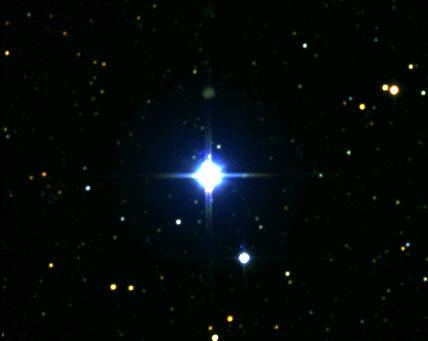
Acrux is a name that was coined around the year 1835 by a celestial cartographer named Elijah. Little if any mythology is associated with this star and constellation. Observers frequently point out that the constellation is not shaped like a Christian cross and that it is merely an exaggeration.
Despite this, many countries love the Southern Cross asterism and the constellation is frequently used as a symbol on the flags of several nations in the Southern Hemisphere.
Formation
Though Alpha Crucis-1 is the main star, being the biggest and brightest, its exact age is unknown however. The second star A2 is estimated to have formed around 10.8 million years ago.
It is possible that the stars formed in this system at roughly the same time and began to be gravitationally bound to one another. Another scenario is that they formed at different times but ended up together.
Alas, the process is quite simple, be it a nebula or a molecular cloud, gravity pulls swirling dust and gas together, and thus stars are born. If the cloud had a lot of materials, more than one star can be born from it.
Distance, Size, and Mass
The Acrux star system is at around 321 light-years / 99 parsecs away from the Sun. The primary star A1 is the biggest of the stellar system. A1 has an estimated mass of around 17.80 times the mass of our Sun.
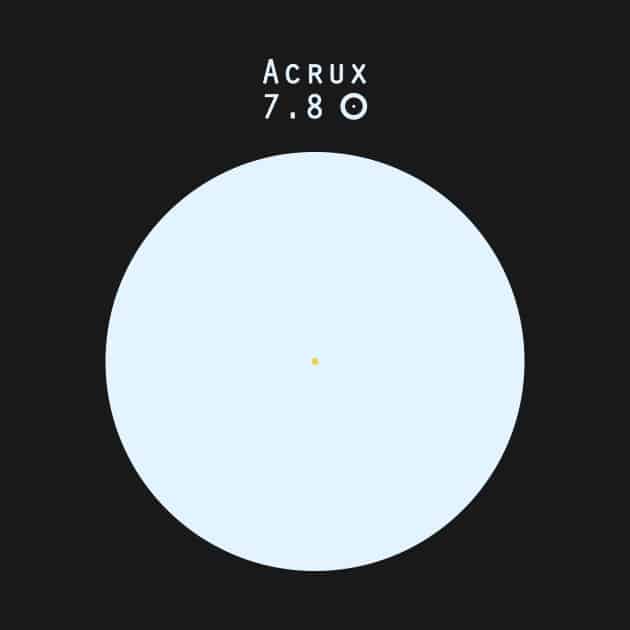
The secondary star A2 is also bigger than our sun, with an estimated mass of around 15.52 times the mass of the sun. A1 has around 7.8 solar radii while Alphac Crucis-2 has around 5.4 solar radii.
Other Characteristics
The brightest star of the Acrux system is A1, being around 25.000 times brighter than our sun, while the secondary star A2 is at around 16.000 times brighter than our sun.
Though A1 is the brightest and biggest of the system, it is almost 4.1 times hotter than our sun at 24.000 K, while A2 is even hotter at around 28.000 K, or around 4.8 times hotter than our sun.
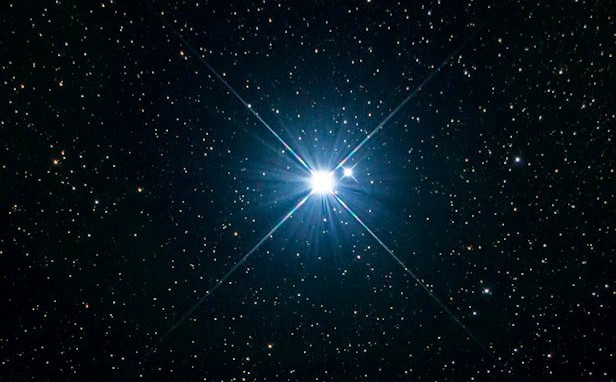
Acrux is variable in brightness, having an apparent magnitude of 0.76 that varies from 1.33 to + 1.75. Its average absolute magnitude is -3.77 and varies from -2.2 to + – 2.7. The rotational velocity of A1 is at around 120 km / 74.5 mi per second, while A2 spins even faster at around 200 km / 124 mi per second.
Stellar System
Both Alpha Crucis-1 and 2 appear to be blue-white in color with A1 having the spectrum of subgiant star, and A2, that of a main-sequence star. They are separated by at least 430 AU and complete one orbit around each other once every 1.500 years. A1 is also a spectroscopic binary star consisting of Alpha Crucis Aa and Ab.
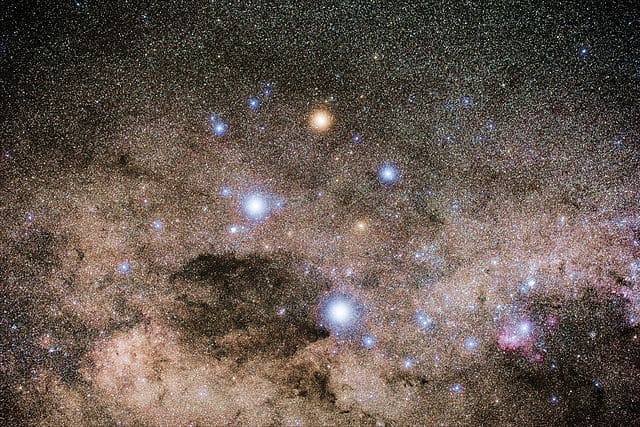
These two stars are estimated to have around 14 to 10 solar masses, are at around 1 AU apart from one another, and complete an orbit once every 75.7 days.
There is also a third component who is much farther away, designated as HD 4729 and having a stellar classification of B5 V. It is a blue main-sequence star, much fainter and cooler than the main pair. It is possible that it is also a subgiant.
It has an apparent magnitude of 4.79, 5.5 solar radii, and it is around 9.65 times the sun’s mass. It is also a spectroscopic binary star that is gravitationally bound to Acrux A and B, sharing their motion through space.
These two stars orbit around each other once every 1 to 5 hours, with the other companion being much dimmer but possibly bigger than our sun – details about it are still unknown.
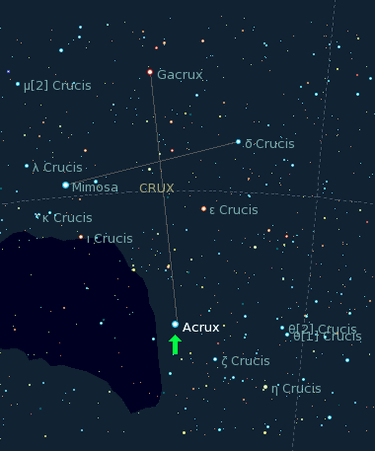
It is estimated that this Acrux C is at around 12 million years old. Many fainter stars are also companions to this system, being at a distance of 2 arcminutes. One of them, designated Acrux D, is believed to be a 15th magnitude star of spectral type M0 V.
Location
Acrux is located in the constellation of Crux, being the southernmost star of the Southern Cross. Observers in the southern hemisphere view Acrux as the bottom of the cross while another star named Gacrux marks the top.
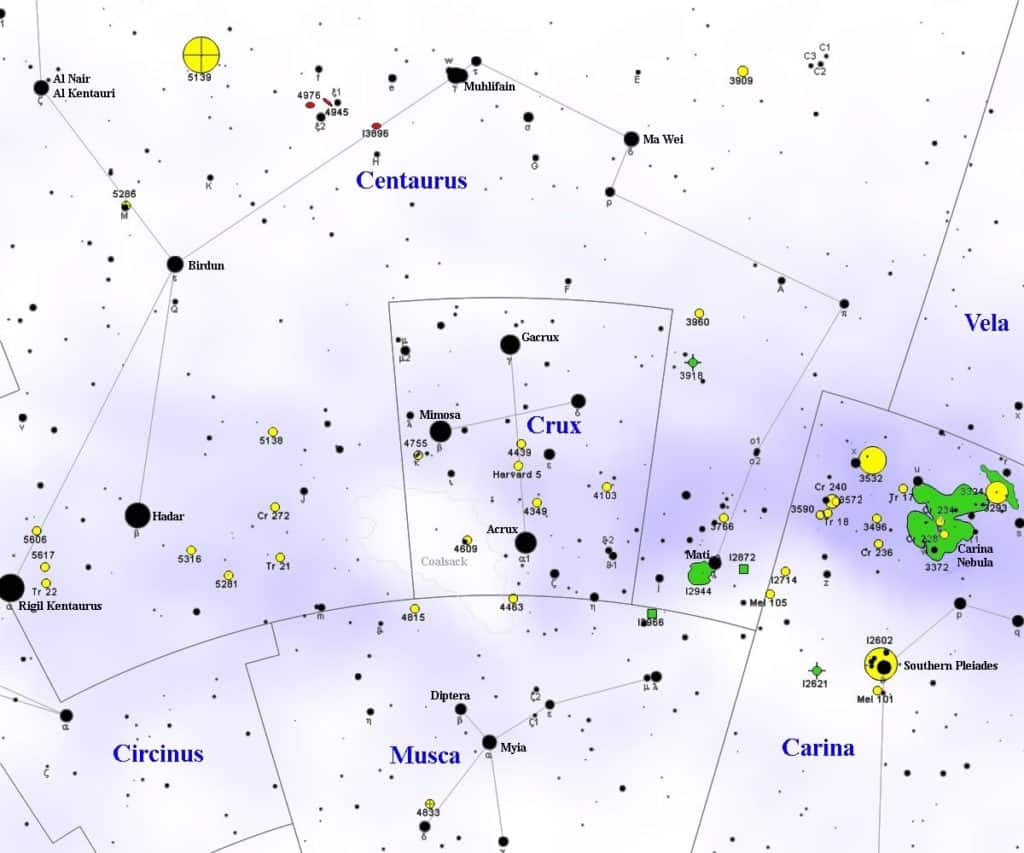
This constellation is the smallest of the 88 constellations, though very recognizable in the southern hemisphere. Its peak visibility occurs during the month of May, many stars, as well as other deep sky objects, are best seen during this month.
The Future
The two smaller components of Alpha Crucis-1, named Alpha Crucis Aa and Ab, are both supernova candidates evidenced through their mass and spectrum characteristics.
Did you know?
- The Southern Cross asterism is one of the brightest in the night sky but it is mostly invisible to northern observers.
- The flag of Brazil features 27 stars with each and every one of them symbolizing a Brazilian Federative Unit. Though the Southern Cross is an asterism, it represents on the flag of Brazil one of the most populous states, named Sao Paulo.
- Apart from Brazil, the Southern Cross asterism is featured on the flags of Australia, New Zealand, Papua New Guinea, and Samoa.
- Acrux is the southernmost first magnitude star, and together with Gacrux, they are among the 58 stars selected for navigation.
- Long ago, Acrux was visible to most northern observers. In ancient Greece and Rome, Acrux was considered to be part of the Centaurus constellation, marking the Centaur’s right hindfoot.
- When it comes to the old Indian astronomy, Acrux was called Tri-shanku.
- For the Portuguese, Acrux was known as the Star of Magellan.
- To the Chinese, Acrux was the Second Star of Cross – this Chinese asterism consists of Acrux, Mimosa, Gacrux, and Imai.
- The celestial south pole lies halfway between the Southern Cross and the star Achernar, as such, Acrux and Gacrux are used to find it.
Sources:
Image source:
- https://upload.wikimedia.org/wikipedia/commons/3/32/Acrux.png
- https://res.cloudinary.com/teepublic/image/private/s–tg2yuHjD–/t_Preview/b_rgb:191919,c_limit,f_jpg,h_630,q_90,w_630/v1559025400/production/designs/4941622_0.jpg
- http://www.astronomytrek.com/wp-content/uploads/2017/05/Acrux.jpg
- https://upload.wikimedia.org/wikipedia/commons/thumb/c/cc/Deep_Crux_wide_field_with_fog.jpg/640px-Deep_Crux_wide_field_with_fog.jpg
- https://upload.wikimedia.org/wikipedia/commons/thumb/0/0b/Acrux_kstars.png/375px-Acrux_kstars.png
- https://www.star-facts.com/wp-content/uploads/2019/09/Crux-constellation.jpg
